6
Research Infrastructure
As capabilities have steadily increased in areas such as spacecraft development, launch systems, modeling and data analytics, instrumentation, and commercial data product services, the space weather community’s view of the future of science mission infrastructure and operations has changed. Emerging trends across these areas will play a major role in re-shaping the architecture that supports efforts to better
understand the Sun–Earth system and the impacts of space weather in space and on ground. Furthermore, the ways that information flows from research to operations and operations to research (R2O2R) are also evolving.
Two panels specifically addressed the issues of the architecture needed to support space weather research and operations. One panel was focused on the Sun and heliosphere, while the other addressed the magnetosphere and ionosphere–thermosphere–mesosphere system. In particular, these presentations addressed the part of the statement of task that asked the committee to
- Take into account the results of studies, including NASA’s space weather science gap analysis (part of the NASA Heliophysics Division’s Space Weather Science Application program) and the NSF Investments in Critical Capabilities for Geospace Science (2016), to identify the key elements needed to establish a robust research infrastructure
The panelists in each of the two panels were asked to address three key questions:
- What are the novel observational/model architectures/technologies that are not yet being used?
- What is needed to build a fluently (i.e., smooth and effective) operating architecture from the multi-source/multi-organization observational base that currently exists?
- What are the government/private resources (data and platforms) that could be used but that are not being used right now?
This chapter summarizes the discussions on those topics and is divided into two main sections, the first on the Sun and heliosphere, and the second on the magnetosphere and ionosphere–thermosphere–mesosphere.
THE SUN AND THE HELIOSPHERE
The New Architectures: Solar and Heliosphere Panel was moderated by committee member Dan Baker. The panelists were Justin Kasper of BWX Technologies, Nicole Duncan of Ball Aerospace, Tom Berger of the University of Colorado, Sue Lepri of the University of Michigan, and Angelos Vourlidas of the Applied Physics Laboratory of Johns Hopkins University.
The panelists used the three key questions above as guidance to explore new architecture issues within their areas of discipline expertise. The topics they discussed included multi-spacecraft small satellite constellation mission architectures; innovative partnerships, contracting, and procurement mechanisms across government agencies; space and ground infrastructure capabilities; and enabling technologies. In addition, the panelists covered new observational vantage points, measurement concepts and their connections, observational gap analysis, and common instrument suites, all in support of advancing space weather–related solar and heliospheric science and research.
The following summarizes the key points from the panel presentations and discussions.
Programmatic, Policy, and Contracting Innovations for New Observations
In Kasper’s presentation, Milestone-Based Reimbursable Space Weather Missions Leading to Department of Commerce or Department of Defense Data Purchase Agreements, he advocated for the development of a commercial data-buy architecture to produce heliophysics data products. Given the fact that launch services, data services, spacecraft systems, and operations are all becoming more commoditized, such an approach would facilitate advanced heliospheric space weather observations at substantially lower cost—and faster deployment time—than existing contractual mechanisms.
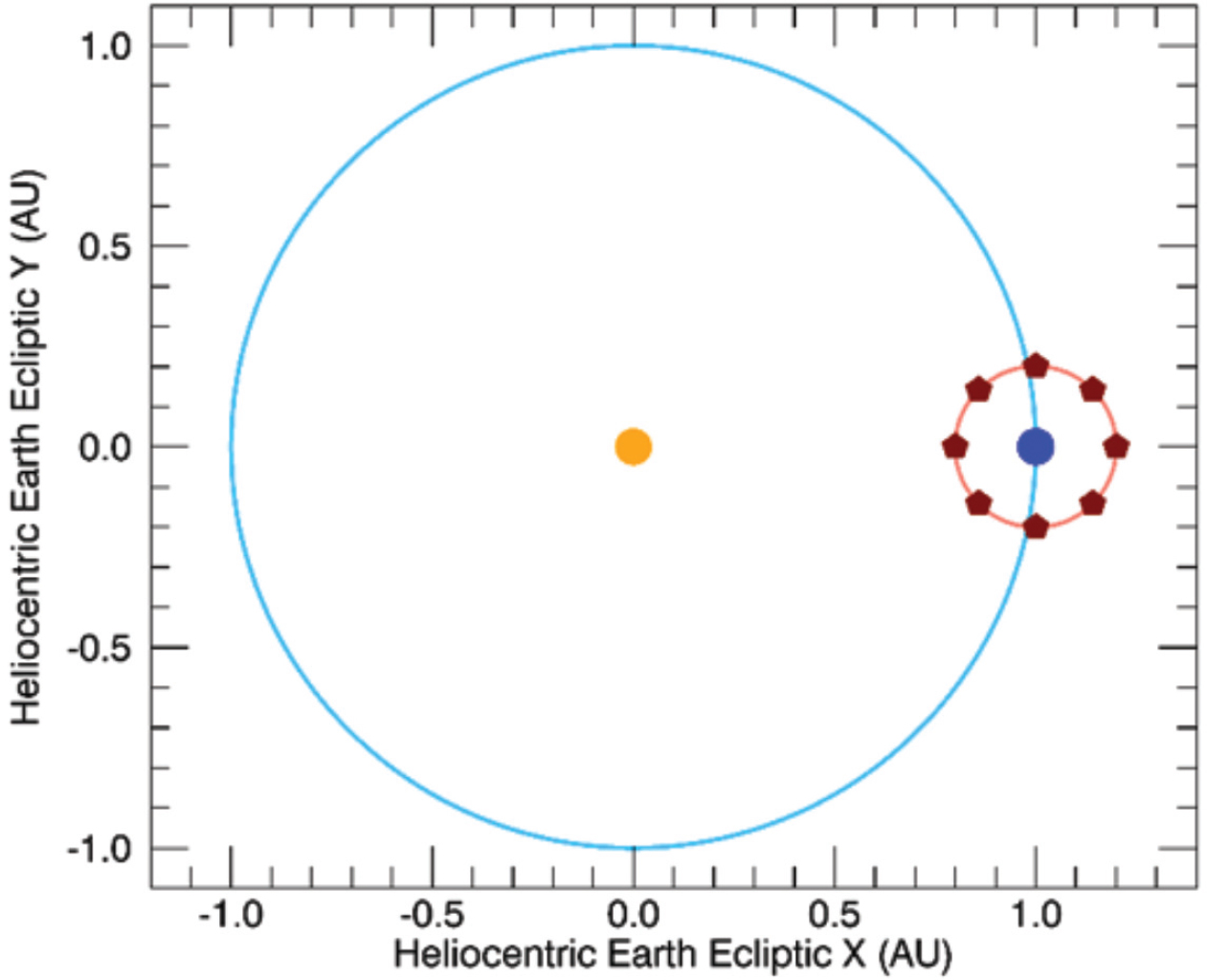
NOTES: The figure captures the appearance of the constellation encircling Earth at a distance of 0.2 AU from Earth. The spacecraft closest to the Sun would give double the lead time as compared to current space weather monitors at L1 at 0.1 AU Sunward of Earth.
SOURCE: Justin Kasper, BWX Technologies, presentation to workshop, April 13, 2022.
Kasper presented an example mission architecture that could benefit heliospheric science simultaneously with providing a milestone-based reimbursable space weather monitoring capability and data purchase agreement structure for the Department of Commerce and Department of Defense (DoD) (Figure 6-1). An eight-spacecraft constellation platform around Earth in a retrograde orbit at 0.2 AU distance from Earth could give advance warnings of transient arrivals with lead times that are longer than can be accomplished with L1 alone. Carrying simple plasma, magnetometer, and radiation sensors, this mission design would give multiple lines of sight and much greater confidence in understanding the magnetic field and probabilities of affecting Earth. At a cost of around $100 million, this infrastructure would allow airlines to take more effective action in response to transient arrivals by having a minimum of 25 hours advance warning with three-dimensional information on shock fronts, flux rope structure, and energetic particles.
Kasper argued that such an architecture could be provided commercially today. Companies could make a profit by selling data through milestone-based reimbursable data purchase agreements with an augmentation from the National Aeronautics and Space Administration (NASA) space weather budget. The challenge in setting up the system is that an interplanetary mission could represent a large upfront cost for a company, as it requires more resources (is more expensive and takes longer from design to operations) than Earth-observation counterparts. A possible solution to this problem would be to develop a mechanism
for commercial data buys where NASA, the National Oceanic and Atmospheric Administration (NOAA), or other interested agencies could enter a milestone-based commercial data acquisition agreement covering the period from instrument development to launch and data production.
In her presentation Enabling Solar and Heliospheric Novel Architectures, Duncan argued that a joint long-term plan and sufficient budget would be needed to enable the sort of novel mission architectures that Kasper described. Duncan mentioned that one approach would be for the U.S. Congress to fund the Promoting Research and Observations of Space Weather to Improve the Forecasting of Tomorrow (PROSWIFT) Act, without affecting other areas of interest, to move the community forward.
Combining scientific and space weather goals has also raised concerns within the science community. From the mission formulation perspective, new technologies can help missions to perform accounting for both scientific and operational needs. Similarly, there are opportunities through the research-to-operations/operations-to-research (R2O2R) Framework for gaining understanding of the operational requirements on the mission design. However, the community concerns about prioritization of scientific versus space weather goals need to be addressed and may require greater flexibility in mission architecture planning.
In addition, mechanisms to transition science mission data to operational use, including the reduction of data latency, are key concerns. The varying success in operationalizing science data could be addressed by greater standardization, and user barriers could be removed by improving data access through standardization and graphical user interfaces. In considering architectures to operationalize mission systems, Duncan said, an industry-prime public–private partnership model has been successful (e.g., with defense customers). In this model, the agency defines the top-level goals, and industry competes to come up with mission definition architectures. As an example, Ball Aerospace uses a mission analysis suite called MOSAIC that optimizes the mapping of top-level goals to mission design (Figure 6-2).
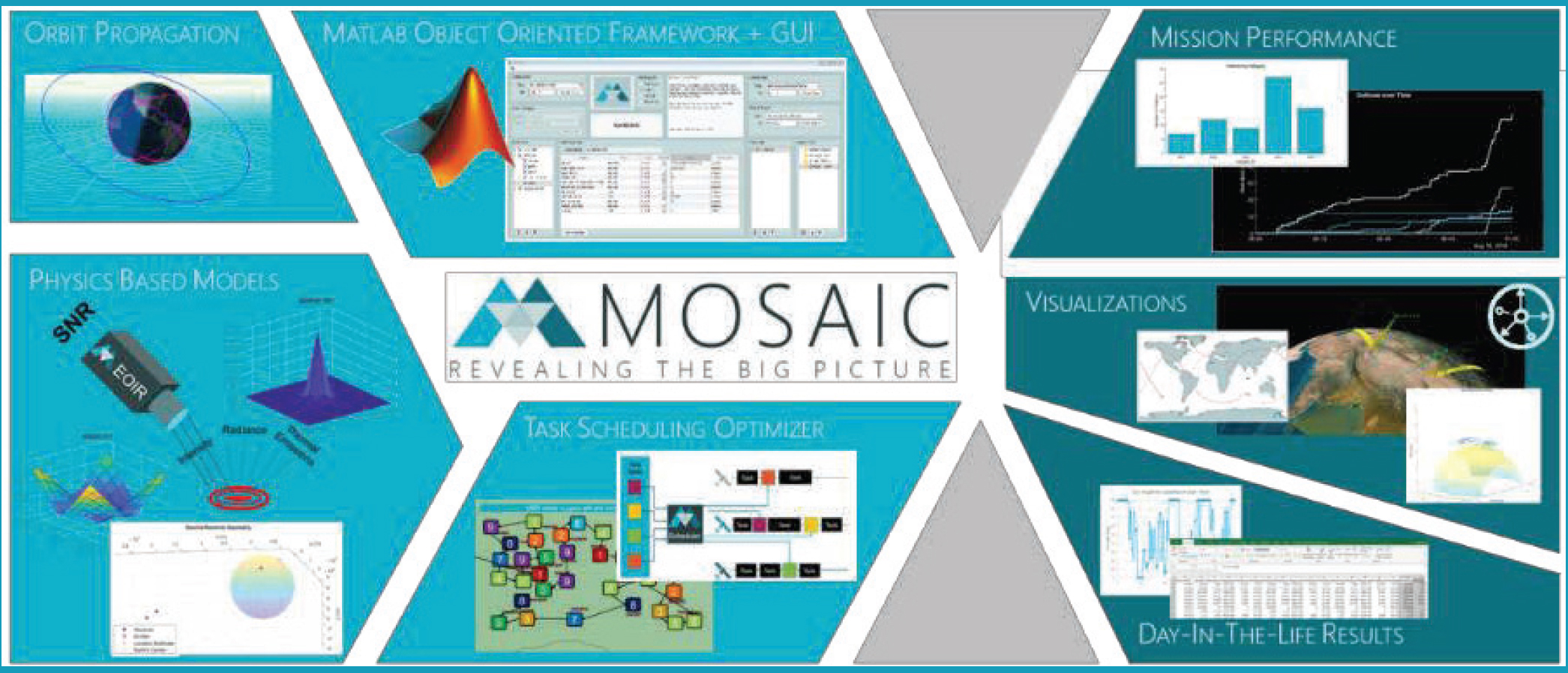
SOURCE: Nicole Duncan, Ball Aerospace, presentation to workshop, April 13, 2022.
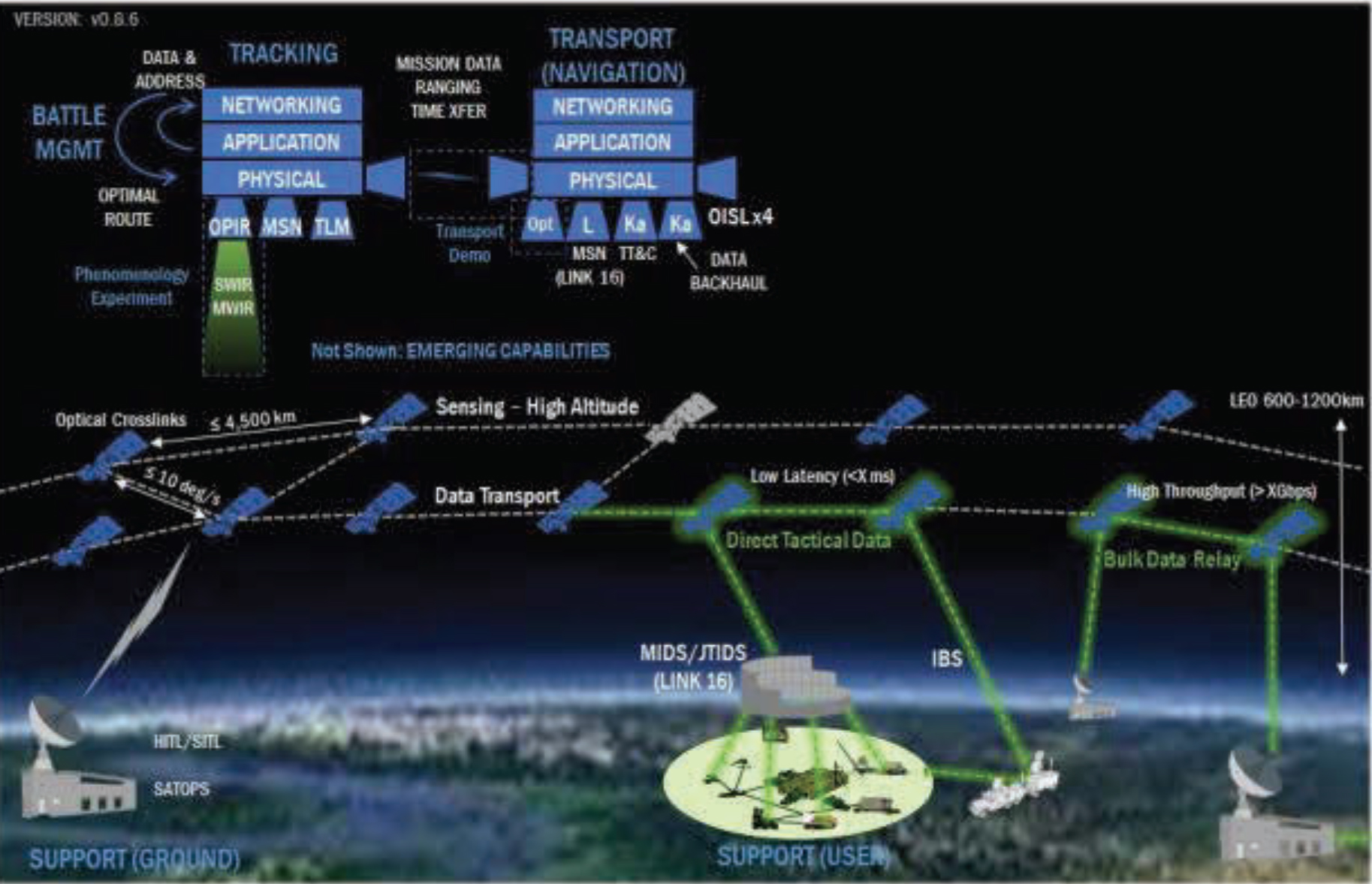
SOURCE: Nicole Duncan, Ball Aerospace, presentation to workshop, April 13, 2022.
Following such commercial practices may lead to lower costs by enabling minimal oversight, reducing deliverables, and using industry-defined mission assurance practices, existing capabilities, and standard interfaces.
Communications infrastructure is another key architectural area where commercial and DoD communication networks could be used to provide data downlink and reduced latency services instead of building new infrastructure dedicated to space weather. For example, expanding NASA’s Deep Space Network (DSN) and increasing launch vehicle rideshare opportunities in collaboration with the Planetary Science Division at NASA could be an effective means of broadening future space mission architectures for heliophysics (Figure 6-3).
Spacecraft constellations offer new opportunities for space weather research and operations, but they may require changing the processes of how missions are currently designed: Rather than building a single large constellation mission at once, one could deploy constellations over time, which would allow for periodic refreshment, increased lifetime, and rideshare opportunities. However, it will be necessary to think about how to structure contracts and procurements—using multiple contracts and minimizing the time between unit builds will be important to achieving sustainable, long-term science observations with resiliency and cost control (see Figures 6-8 and 6-9). In addition, the architecture needs to account for constellation-specific technologies, such as autonomous formation flying in the near-Earth environment,
which can affect space traffic management. While it is unclear exactly what the next-generation mission architecture will look like, the policy and resources issues must be considered early.
Finally, those designing the constellation missions will need more guidance on assurance expectations, approaches to testing, space traffic management, and the need for on-board artificial intelligence and machine learning. The framework for technology readiness level (TRL) maturation and qualification is as yet not well understood for the constellations; these issues must be addressed to ensure successful heliophysics constellation architectures.
New Architectures to Overcome Observational and Modeling Deficiencies
In the next presentation, 4π HeliOS Mission Concept to Advance Space Weather Research and Operations, Berger discussed how current observations of the Sun are very limited (Figure 6-4), which inherently limits the accuracy of all existing space weather models. Currently, solar observations are confined largely to the Sun–Earth line. Even when a map of the full Sun is produced using the Sun’s rotation, the map does not represent an instantaneous state of the Sun at any given time but instead is a convolution of temporal evolution and spatial information.
The view from the ecliptic plane contains limited information, as only about a third of the solar surface is visible at any given time. To estimate the synoptic solar flux, the measured values are extrapolated to the total solar output (see Figure 6-4), where the full modeling process introduces a forecasting delay
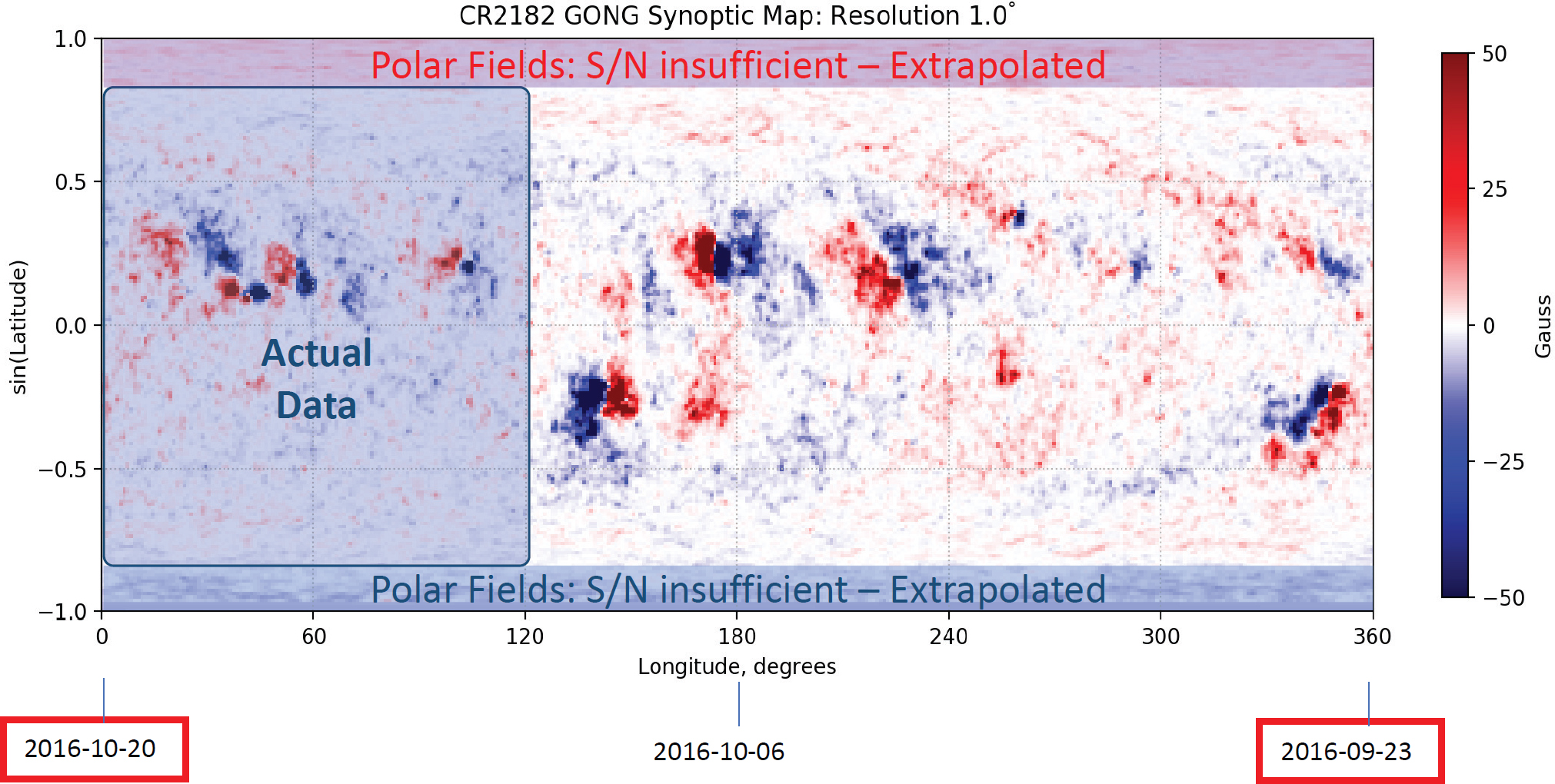
SOURCE: Tom Berger, University of Colorado Boulder, presentation to workshop, April 13, 2022.
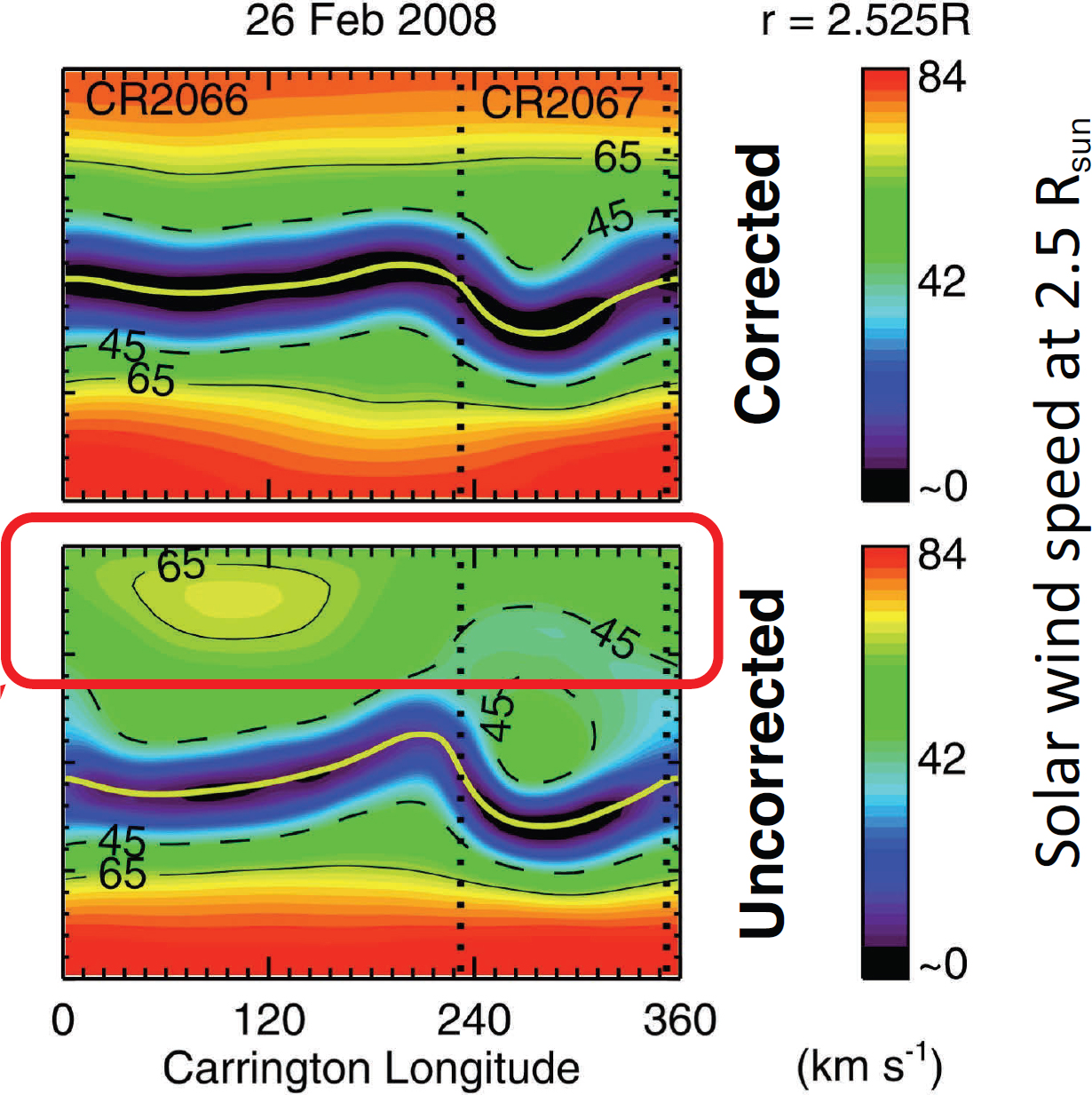
SOURCE: Tom Berger, University of Colorado Boulder, presentation to workshop, April 13, 2022.
of greater than 10 hours. Furthermore, inaccuracies in the polar extrapolations, which are used as model input, lead to very poor values for the solar wind speeds, which in turn compromises arrival time estimates for coronal mass ejections (CMEs). An example of the impact of the gap in observations at high solar latitudes is demonstrated in Figure 6-5, which shows that the fast wind from the Sun’s northern polar regions is missed by the uncorrected polar field extrapolation.
The 4π HeliOS mission concept (Figure 6-6) would advance space weather research and operations by providing full solar coverage more than 80 percent of the time over the mission lifetime. The architecture consists of two solar–polar and two solar–quadrature (ecliptic plane) spacecraft, all of which are three-axis stabilized imaging platforms. The addition of an L1 mission would increase coverage along the Sun–Earth line over a 10-year mission lifetime. The solar–polar orbital inclination should be at least 60 degrees, with greater than 80 degrees desired. The solar–quadrature elements would be placed between ±90 and ±120 degrees, without requiring the use of the L4 or L5 points. All spacecraft would have perihelia of about 1 AU with a common instrument suite to facilitate intercalibration and redundancy.
The HeliOS instrument suite would combine in situ and remote sensing instruments. The remote sensing components would include a solar spectral irradiance monitor, Doppler vector magnetograph, an extreme ultraviolet (EUV) imager, and a white-light coronagraph. The in situ instruments would include
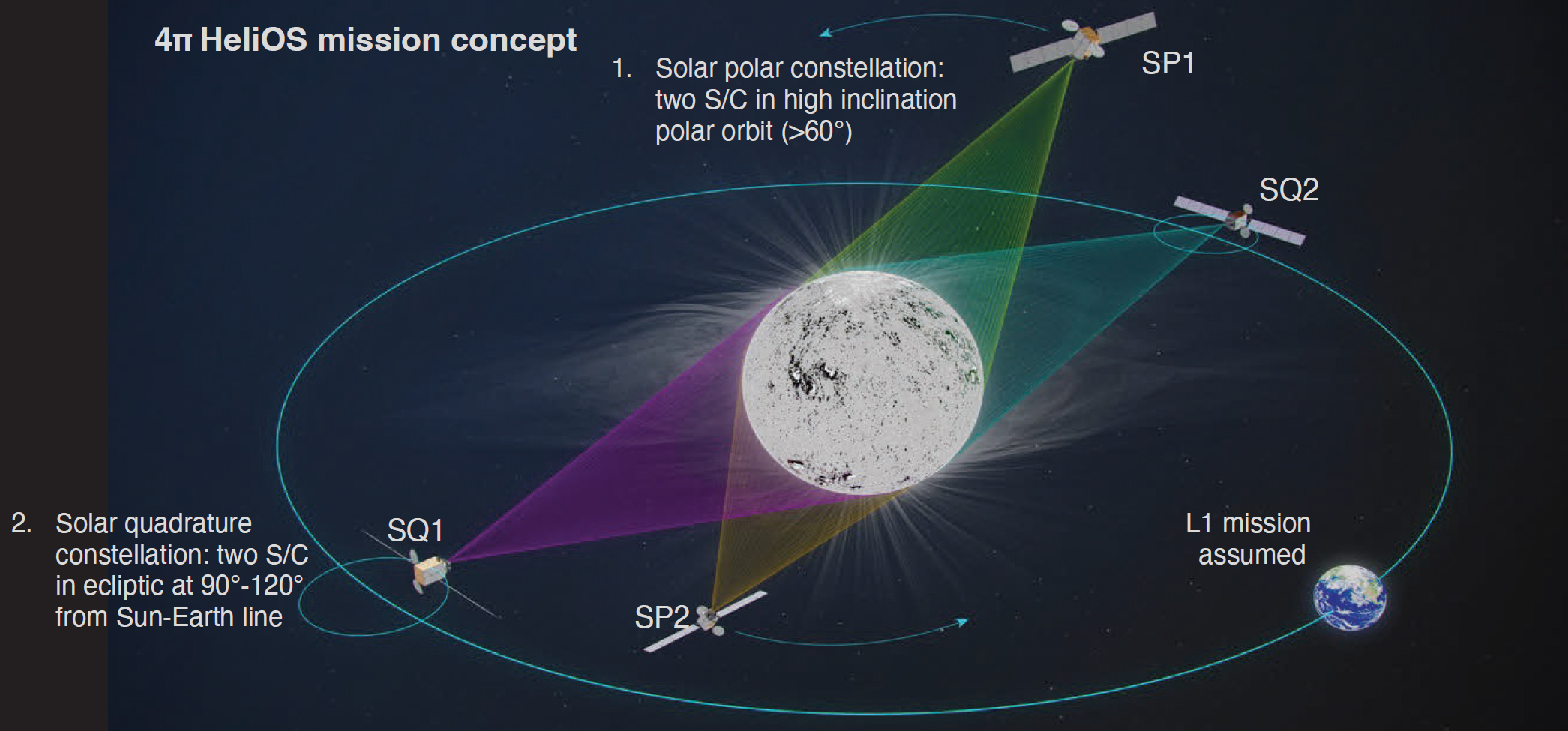
SOURCE: Tom Berger, University of Colorado Boulder, presentation to workshop, April 13, 2022.
a magnetometer, a solar wind plasma analyzer (Faraday cup), and an energetic particle suite. Additional capability would come if it were possible to include additional instruments. For example, the addition of Golf-NG (Global Oscillations at Low Frequency-New Generation) would allow detection of the solar gravity and g-modes, and thus probe the rotation rate of the Sun’s core.
As envisioned, this mission concept still has significant technological challenges, including acquiring terabytes of data per day in near real time and using optical communications with associated deep space optical infrastructure to relay the data to Earth. Furthermore, if a single launch vehicle is to support both north and south polar spacecraft deployments, it must be equipped with ion or nuclear/thermal thrusters and be compact and lightweight enough to get out of Jupiter’s gravity well. Autonomous spacecraft and data systems are a must to support helioseismology, which requires 100 msec-level accurate timing across the constellation. The mission complexity overall means that artificial intelligence and autonomy would be required.
In Lepri’s presentation, Perspectives from the Heliosphere: ICMEs, SEPs, Suprathermal Particles and the Nature and Structure of the Solar Wind, she emphasized how observational gaps related to ICMEs (interplanetary coronal mass ejections), shocks, and the bulk solar wind limit the space weather forecasting/nowcasting capability and the understanding of how to derive key parameters, such as time of arrival, duration, and the geo-effectiveness of the structures at Earth. An example is show in Figure 6-7.
The key features to detect include the ICME structure, extent, and magnetic topology. Similarly, it is necessary to know the time of arrival, the boundaries, the duration, and the plasma and magnetic properties of solar wind structures, such as high-speed streams (HSSs), stream interaction regions (SIRs),
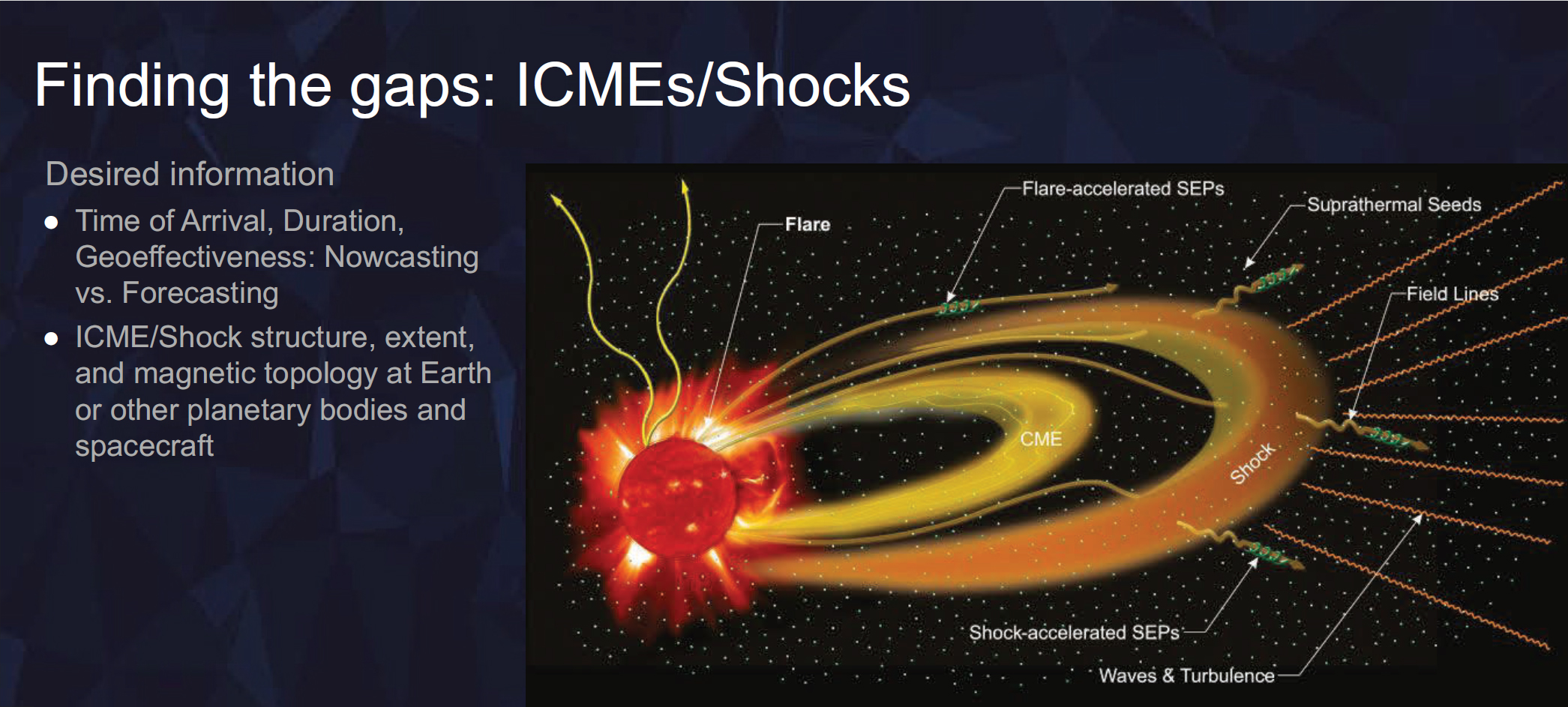
NOTE: SEP = solar energetic particle.
SOURCES: Susan Lepri, University of Michigan, presentation to workshop, April 13, 2022; image from M.I. Desai and D. Burgess, 2008, “Particle Acceleration at Coronal Mass Ejection–Driven Interplanetary Shocks and the Earth’s Bow Shock,” Journal of Geophysical Research 113(A9), https://doi.org/10.1029/2008JA013219; copyright 2008 by the American Geophysical Union.
and corotating interaction regions (CIRs). Key open questions include the evolution of these structures as they travel through the heliosphere, including effects of preconditioning (previous events and prior state of the solar wind into which the structures expand) and the influence of the solar cycle phase. Addressing these questions will require monitoring the three-dimensional heliosphere with the ability to identify these phenomena.
Lepri said that there are significant gaps in existing in situ measurements as well as in the current ability to connect remote and in situ measurements. Enhanced observations and modeling efforts are needed to connect remote observations (line of sight integrated) to in situ (point) measurements. There are also limitations in the current instrumentation: most of the currently operative instruments cannot capture sufficiently high solar wind speeds or proton fluxes to accurately record the largest events (solar wind speeds may get up to 3,000 km/s). While heavy ion composition has shown promise in identifying different solar wind types, the lack of real-time monitoring of the ion composition adversely affects the quality of space weather nowcasting.
Heavy ion composition, which is a significant gap in current in situ plasma measurements, plays a key role in differentiating HSSs from ICMEs, in determining the internal structure of the ICME, and in constraining models of CME initiation, energization, heating, release, and propagation. These observations are essential to nowcasting and to quantifying the total mass and pressure of a space weather event. Composition information is now being incorporated into models, but validation data are still scarce. If composition measurements were available, they could be a key discriminating marker for machine learning (ML) algorithms used to identify and predict ICMEs, and can thus improve the ML methodology effectiveness.
Suprathermal particles are the leading indicator of shocks, and provide 5-72 hours of warning, depending on the strength of the shock. As suprathermal particles are also the seed population for solar energetic particles (SEPs), they provide a great forecasting metric. However, being less abundant than the bulk of the solar wind, their observation is more challenging. Many current particle instruments lack the dynamic range or sensitivity to cover the many orders of magnitude required to resolve the suprathermal component. The instruments are also not able to resolve smaller-scale composition and structural changes, because of the longer integration periods required.
Ultimately, the goals of observing the suprathermal and heavy ion components should be to enhance predictive capability, understand the background solar wind, and build a climatology of solar wind parameters. Mission architectures to support those goals would include distributed systems both in and out of the Sun–Earth line. Lepri listed a number of measurement priorities, including in situ plasma and energetic particle (composition) measurements at various distances ranging from 0.7 to 1 AU to track the flow and spatial variations occurring en route. Such a distributed network could also be achieved by using instruments hosted on planetary missions. Other priorities include complementary measurements across platforms to combine remote and in situ measurements, and getting long baselines and uniformity by sustained observations producing long-term data series.
Achieving this enhanced capability will require overcoming significant challenges. New capabilities (high-resolution proton and electron measurements, heavy ion composition, suprathermal particles, SEPs, and magnetic field) will be required to determine the impacts of smaller-scale structures. This, in turn, will require increased telemetry and real-time data downlinking capability, both of which may need novel onboard processing or advances in ground-based data-analysis tools.
Lepri used particle instruments as an example of challenges faced when increasing instrument requirements: higher resolution requires larger fields of view or geometric factors. Extending the mass, charge, or energy range of a measurement typically requires larger sensors, while the necessary instrument miniaturization is especially challenging for those needing high-voltage power supply. Each mission and architecture design must decide on the trade-off between the value of smaller, simpler instruments and the cost of more complex and capable sensors.
In the next presentation, Novel Observational/Model Architectures/Technologies to Fill Gaps in Observations of Solar Transients, Vourlidas followed the themes outlined in the NASA heliophysics gap analysis report by discussing the gaps in solar observations, starting with the observations of solar transients: CMEs, high-speed streams, shocks, and associated energetic particles. A key theme in his presentation was the lack of effective three-dimensional coverage of how the transient events evolve over time. Two key measurement challenges are the lack of coverage of events, and the scale mismatch of the observing techniques, with the in situ techniques having higher temporal resolution but sampling at just a single point, while imaging provides broader coverage but with spatial resolutions that are 1,000 to 10,000 times coarser.
Vourlidas emphasized the importance of taking a systems-level approach focused on multi-scale measurements as a way to address gaps due to sparse coverage and the multi-scale nature of the phenomena of interest. Such a system was discussed in the Berger presentation (Figure 6-8). A strategic plan and systematic approach are needed to build up such a system in response to the gap analysis report. The key new elements of this architecture are (1) that the platforms would be distributed (rather than monolithic), (2) the platforms at the Lagrange points would be in “quadrature” (four spacecraft rather than the currently used single vehicles), and (3) the spacecraft would carry only focused payloads (smaller numbers of sensors) (Figure 6-9). Novel approaches, such as the use of CubeSats and in situ constellations, could address some of the sampling issues. Communications will present a challenge, particularly for the envisioned far-side sensors. (See also the Berger presentation above.)
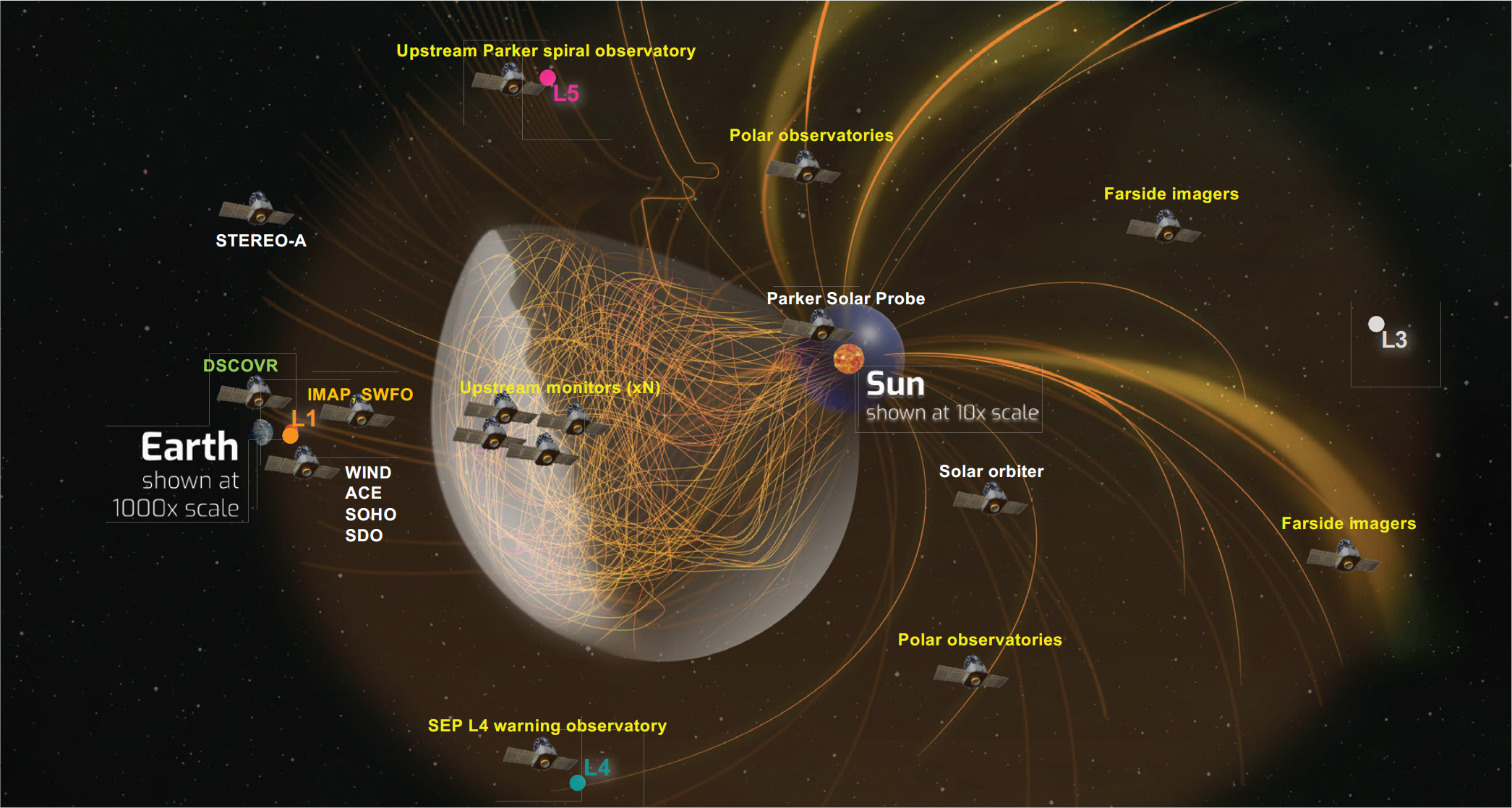
NOTE: Acronyms defined in Appendix D.
SOURCE: Angelos Vourlidas, Johns Hopkins University Applied Physics Laboratory, presentation to workshop, April 13, 2022.
Vourlidas spoke about the importance of developing architectures that bridge the major gap that exists between solar, heliophysics, and geospace research. In bridging the gap from the solar wind to geospace, care must be taken to implement a “peri-geospace” architecture that would include a system of L1-Earth “cyclers.” These dedicated platforms would provide sampling of solar wind conditions off the Sun–Earth line and address the transient scale problem important for space weather.
Finally, Vourlidas commented that user requirements as of today are not sufficiently well defined to determine the measurement architecture. Developing a cost-effective strategy will require research and a modeling of the system (through observing system simulation experiments [OSSEs]) to determine the most effective measurement strategies. It is likely that new partnerships are needed to achieve these goals.
Interactive Panel Discussion
After the panelists finished their presentations, they took part in a broad-ranging discussion with questions from the viewing audience. Three major needs emerged from the discussions:
- More complete coverage of the Sun (i.e., from all directions).
- More comprehensive measurements, including high-resolution (in both time and energy) measurements and measurements with large dynamic range.
- New capabilities for managing the data volumes being produced, including techniques for processing data onboard the spacecraft, and autonomy for operations and data collection. A recurrent theme was the need for some key information to be provided in near real time.
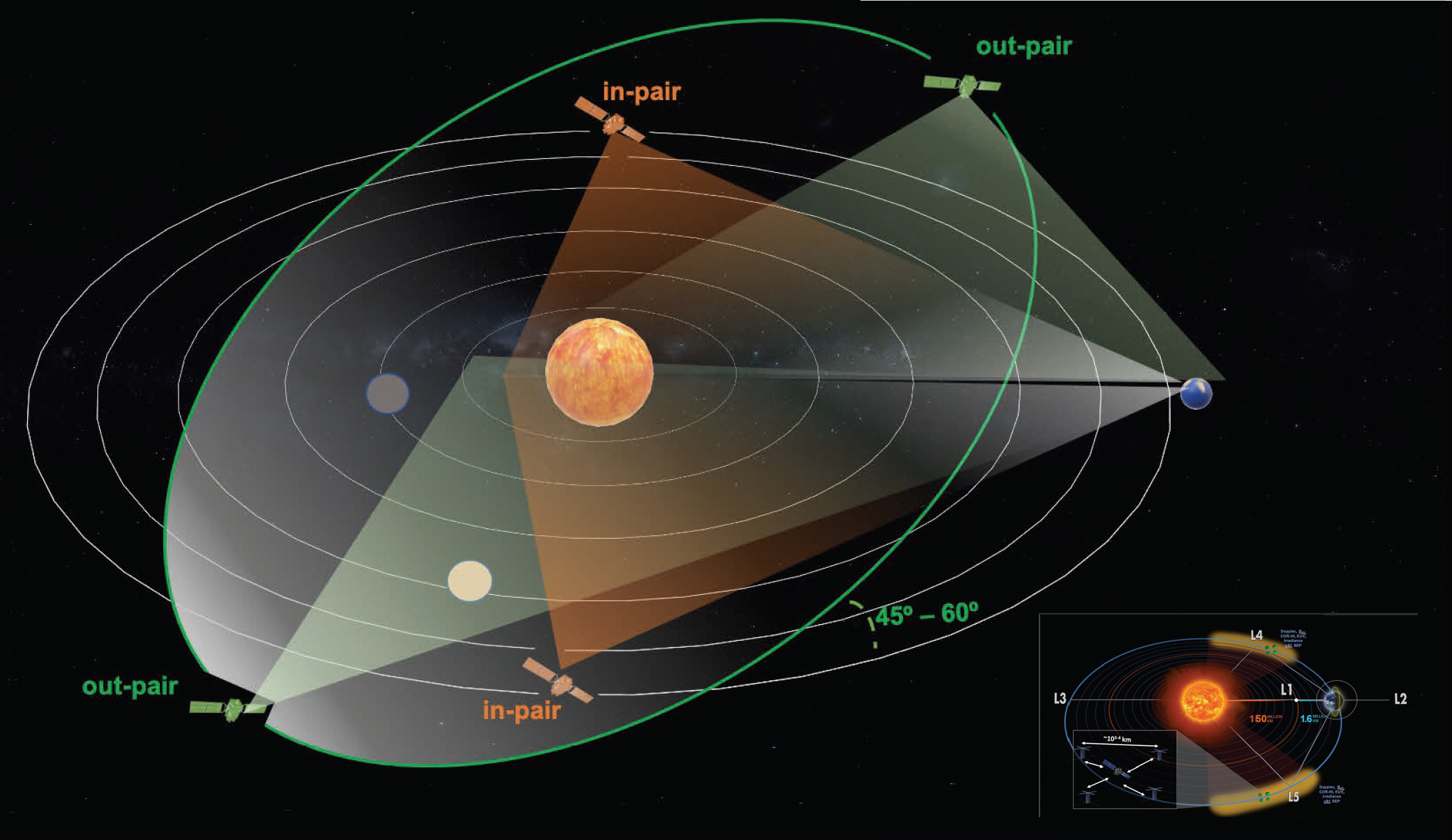
SOURCE: Angelos Vourlidas, Johns Hopkins University Applied Physics Laboratory, presentation to workshop, April 13, 2022.
While the panel did not explicitly address costs, the requirements they outlined suggested that new ways of managing programs will be needed to increase the efficiency of the building and operations of constellations as well as the efficiency of data delivery. Constellations built by multiple partners and in phases could support development of sustainable mission architectures constructed in affordable steps. Enabling data buys was viewed as a viable alternative to the traditional NASA/NOAA-funded data collection.
The discussion also touched on public–private partnerships for data provision. Two main points were made: First, industry does not like to accept risk for data production when the customer is basically one organization (NOAA or NASA, depending on whether the data are for monitoring or for science). Second, NASA and NOAA follow different procurement and implementation practices than those used by industry. Industry practices are purported to yield lower costs at low risk by following standard, proven practices and eschewing unnecessary documentation and reviews. Sharing risk would require changes in the current NASA and NOAA procurement process. Finally, the mission class system followed by NASA does limit flexibility, especially when measurement continuity is desirable. A possible solution would be to address the funding profile constraints with fractionated or heterogeneous approaches that would allow NASA to match science and operational data collection needs by adjusting the makeup of the elements of the heterogeneous constellation or providing a needed measurement on a rideshare or hosted payload. It was also suggested that there may be ways to transition a science mission to an operational one once the prime science phase is completed, even if there are significant differences in the measurement requirements; however, these issues were not explored further.
Panelists also raised some concerns about public–private partnerships. In particular, broad industry involvement requires a clear understanding of the return on investment (ROI) and careful justification to the shareholders—examples were quoted where commercial data production has ended due to lack of ROI. It was also questioned how the R2O2R cycle would operate in such a setting, or how the funding profiles would be established and managed.
The discussion on mission architectures raised a question on how mission planning changes when considering a design that moves the research-to-operations (R2O) process up front, and how the OSSEs may be used to explore such questions. Furthermore, the OSSEs can be used to study how the constellation sizes affect science closure, the value of measurements for operational nowcasts and forecasts, and the orbits where measurements are most needed. The panel generally agreed, however, that new architectures do not need hundreds of spacecraft in deep space, just dozens in critical places.
Finally, the panel discussion continued the previous discussion on the need for new types of measurements and novel instruments, with general agreement that developing new instruments and technologies is best done in a university setting, which offers opportunities for innovation and workforce development through student involvement.
MAGNETOSPHERE, IONOSPHERE, AND THERMOSPHERE
The New Architectures: Magnetosphere–Ionosphere–Thermosphere Panel was moderated by committee member Dan Baker. Its panelists were Phil Erickson of the Massachusetts Institute of Technology’s Haystack Observatory, Brian Anderson of the Applied Physics Laboratory of Johns Hopkins University, Robyn Millan of Dartmouth College, Katelynn Greer of the University of Colorado, and Erik Babcock of SpaceX. Asked to consider the same three key questions as the New Architectures: Solar and Heliophysics Panel, the members of this panel followed the first one by discussing how capability enhancements influence ways to develop new missions. The specific topics discussed by this panel included the role of ground-based research-grade instruments and nontraditional data sources, commercial data acquisition, data fusion and heterogeneous ground-space-based multi-point distributed measurements, and the impact of space weather and situational awareness on the ability to deploy spacecraft safely in low Earth orbit.
Infrastructure and Data Systems for New Observations
Erickson’s presentation was titled Ground-Based Instruments: Considerations for Usable Space Weather Data. He spoke about the role of ground-based research-grade instrument infrastructure and the considerations and challenges involved with supplying usable space weather data. For example, incoherent scatter radars (ISRs), such as the European Incoherent Scatter Radar (EISCAT 3D), are designed with flexibility in mind and have many modes, which makes it challenging to incorporate the data into a standard space weather feed.
Nevertheless, he considered that it is possible to design instruments to serve both research and space weather needs. Ideally, research instruments would be designed from the start to also produce space weather feeds, and all instrument designs would keep multiple analysis and operation pathways viable to allow both flexibility for research as well as uniformity and reliability for operations. For example, space missions addressing the science of space weather deliver a series of data levels, from basic (Level 1) to various derived data products (Levels 2, 3, 4), of which Levels 3 and 4 could be usable for operations. He concluded that operational space weather products need well-characterized measurement fidelity and uncertainties as well as low latency.
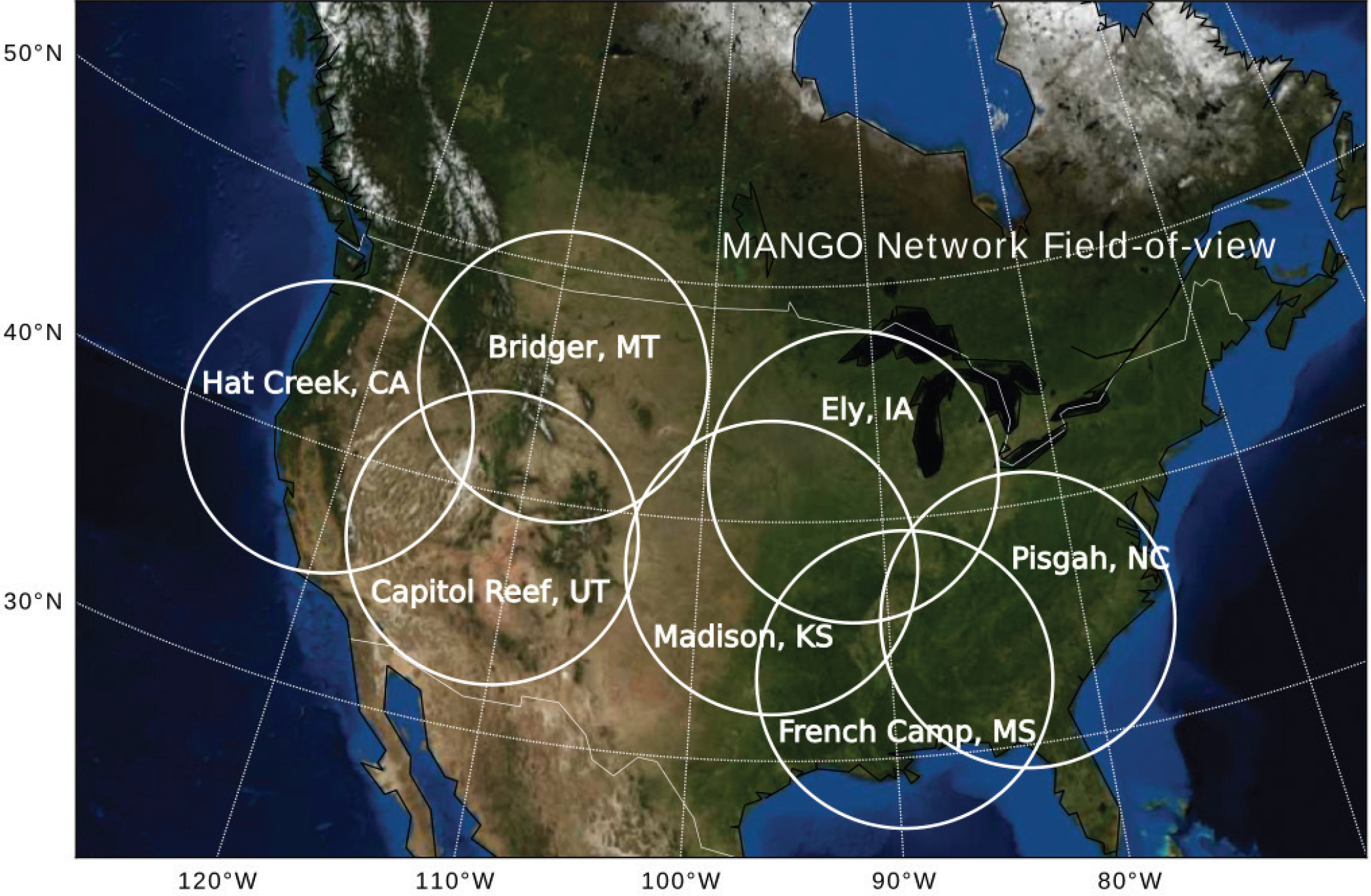
SOURCES: Phil Erickson, Massachusetts Institute of Technology Haystack Observatory, presentation to workshop, April 14, 2022, from MANGO Project Team, SRI International, used with permission.
As measurements are being gathered for a particular purpose, their anticipated future use should be kept in mind when deciding on which metadata are being stored. For example, in the case of meta-instruments such as GNSS TEC1 and MANGO (Figure 6-10), the “instrument” is the software used to combine the networked data collected for another purpose. However, Erickson pointed out that foreseeing what the future use of the data might be—and which metadata that might require—will be challenging.
Advances in space weather predictions will require multiscale observations with networks of sensors. Such operational space weather measurement systems must be designed as networks from the start. As discussed in other panels, the OSSEs can characterize optimal instrument placement, performance, and use, and thus help in designing the network. Furthermore, to make full use of the data will require incorporating the observations into data assimilation schemes.
___________________
1 In the GNSS-TEC database, global total electron content (TEC) data were derived from data collected by a Global Navigation Satellite System (GNSS).
Finally, nontraditional data sources, such as the amateur radio community, can provide potentially useful observations with unique spatiotemporal sampling rates. However, the use of such crowd-sourced data has its own challenges related to quality and availability. The different needs of the end users may limit the use of such data sets—retrospective analysis for scientific advances can be more accommodating than the operationally oriented space weather applications, whose needs require a rigorous approach to data production.
Erickson also commented on the workforce development pressures that arise from the need to understand the production-level requirements of the space weather systems. This shared understanding can only be developed if the O2R and R2O efforts are done in interagency cooperation.
In her presentation, Building a Fluently Operating Architecture, Greer described how ionosphere–thermosphere–magnetosphere science could be addressed by heterogeneous data sets from ground- and space-based instrument platforms provided by governments, industry, and academia (Figure 6-11). Such an approach would require new approaches to overcome the challenges related to the calibration, validation, and verification needed to take advantage of the full power of large, distributed constellations. Cross-platform and cross-instrument comparisons should be part of the mission design from the start, especially when considering long-term monitoring. Data assimilation will be required to make full use of the measurements.
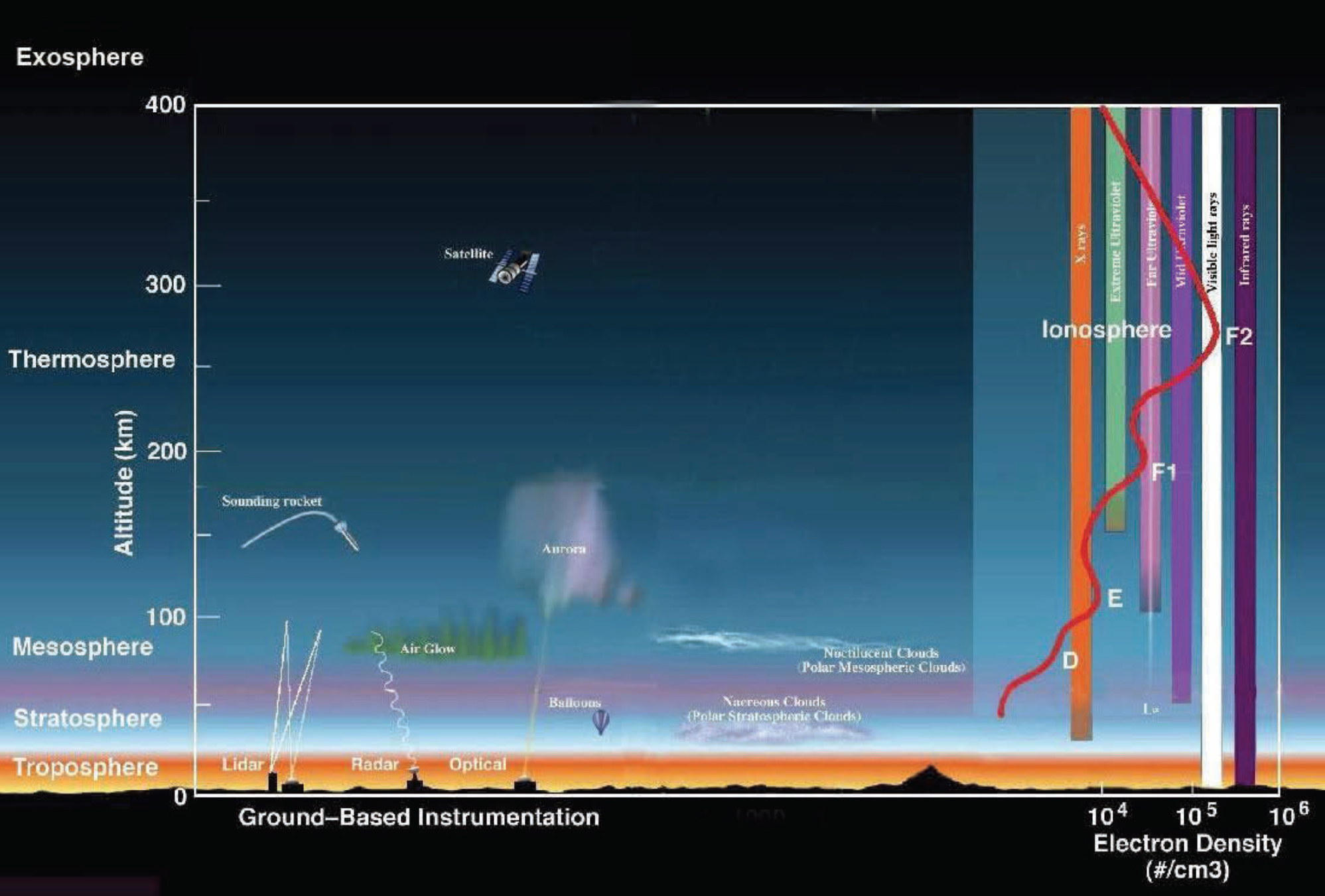
SOURCE: Katelynn Greer, University of Colorado Boulder, presentation to workshop, April 14, 2022.
Greer also noted the need for resources and agency coordination to ensure that instruments will be available and operational on the timelines required and that the instrument operators are incentivized to support the data taking. While this may not be considered the most glamorous work, it will be necessary for successful use of distributed resources.
Millan’s presentation, The Radiation Belt Environment, emphasized how the infrastructure for the new space applications increases the number of satellites that encounter the radiation belts and their effects. Specific elements of the fleet include GPS, weather, and communications satellites. The space weather effects that the spacecraft encounter can be either localized or extended across the system; the strongest particle fluxes—and thus the greatest hazards to spacecraft—occur in the region bounded by the geosynchronous orbit (GEO) from above low Earth orbit (LEO) from below.
The end of NASA’s Van Allen Probes mission in 2019 meant losing continuous monitoring of the radiation environment from the geostationary transfer orbit, which cuts through the critical radiation belt region. Those measurements cannot be replaced by either the data from the Geostationary Operational Environmental Satellite (GOES) system at GEO orbit, where the fluxes are much lower (Figure 6-12), or by operational data from the LEO orbits, which sample only a small portion of the particle distribution. Continuous monitoring of the radiation belts would be important both for scientific understanding, as predictive capability does not yet exist, and for operational space weather monitoring purposes to protect assets in orbit.
Millan described ongoing efforts to take advantage of opportunities to gain radiation belt monitoring capability. Given sufficient advance planning and resources, real-time space weather beacons, built based on the experience from the Van Allen Probes, could be realized in collaborations between NASA, NOAA,
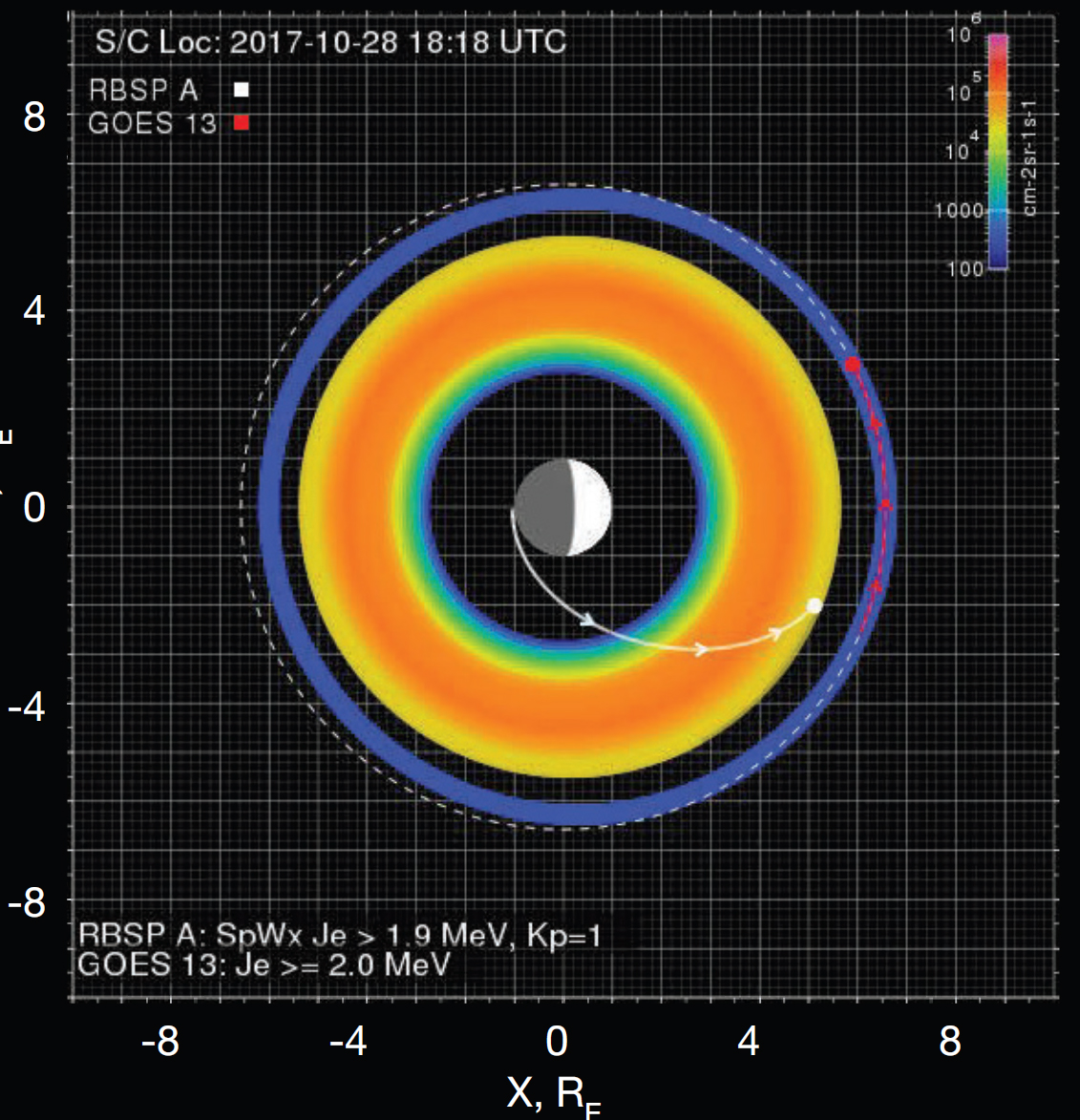
SOURCE: Robyn Millan, Dartmouth College, presentation to workshop, April 14, 2022.
and international partners. Small satellites, such as CubeSats at LEO (built by the National Science Foundation, NASA, or international partners) or the Geostationary Transfer Orbit Satellite (GTOSat) flying through the high-radiation environment, offer new opportunities for radiation belt monitoring. Hosted payload approaches include the Responsive Environmental Assessment Commercially Hosted (REACH) constellation and those on Iridium NEXT, both of which are currently confined to LEO.
The collection of multi-point distributed measurements is a critical need for science, particularly as input into empirical and physics-based models. However, Millan said that it is not yet clear which measurements, which measurement locations, and how dense a network will be required to provide the scientific advances, as such studies have not been carried out in a comprehensive way.
Nowcasting and forecasting need real-time monitoring. Ensuring sufficient observational input for space weather products will require policies and programs that would increase the availability of measurements, including private–public partnerships, data buys, and addressing the barriers preventing international cooperation (an area the Committee on Space Research [COSPAR]) panel on space weather is seeking to address).
Furthermore, distributed observations present challenges that require new solutions. Onboard processing and artificial intelligence will be needed to address issues with data downlink and pipelines to operational centers. Space-based observations need to be combined with simulation, models, and ground-based data sources, which may require new approaches.
Finally, using commercial data has proven to be labor intensive and limited by the architecture that defines the resolution, availability, and other key metrics. Getting the best possible observations requires both coordination between the commercial and academic partners and buy-in from the commercial entities.
Impact of Commercialization on New Architectures for Space Weather
Anderson’s presentation, Commercial Data Acquisition for Space Weather, focused on the various challenges of acquiring space weather data from commercial providers. One challenge is that U.S. government procurement processes and timelines are not well suited to engaging with commercial providers, because commercial entities move faster and have different mechanisms for approving commitment to projects. This leads to a situation in which the needs of scientific data collection are generally addressed only after the measurement system has been built.
Including custom instruments onboard commercial satellites requires close interaction with vendors, as support for instrument integration and operation may require significant vendor involvement. Generally, customization may not be possible, and the commercial vendors give no guarantees of performance versus requirements. Getting real-time data from a commercial partner requires a value proposition that appeals to the provider—opportunities for data buys arise once the product is developed. Anderson said that there are significant differences between the data acquisition strategies for science use and real-time space weather use: For research, data acquisition can be economical since delays and gaps can be tolerated. For space weather, all data have to be available in real time, and processing needs to be robust.
Low Earth orbit hosts an increasing number of sensors, which form a heterogeneous network that offers opportunities both for scientific and space weather use. Data acquisition for research can be economical, particularly if it is done on a non-interference basis with a commercial mission without assurance of continuous data access. However, scientific use typically requires intercalibration of the sensors, and data assimilation into a common framework can be a challenge if there are data quality issues or if required ancillary data are not readily available. Space weather use poses more requirements to the provider. Real-time data access may affect various system and staffing issues, as on-call staffing must be robust and available 24/7. In such cases the benefit to the commercial provider must be strong.
Anderson concluded that commercial data tend to be heterogeneous. The distribution of observations, although it may be “global,” is dynamic and uneven. There may be very different levels of accuracy and noise in the measurements, so the errors and uncertainties of each data source need to be quantified, and covariance verification should be used to cast the information in a useful form for assimilation analyses. Such problems can be treated with multi-parameter assimilation, but even if it has been used for tropospheric weather, it is still an emerging capability and would require significant new research before it could be applied to operational products. Nevertheless, such methods may provide new insights for first-principles models for intense and unusual events.
In the panel’s final presentation, Space Weather and Space Situational Analysis, Babcock, from Starlink Guidance, Navigation, and Control at SpaceX, provided a commercial perspective on the importance of space weather data for constellation management and collision avoidance in low Earth orbit. Both tasks require a good understanding of space weather processes, most importantly the ability to predict thermospheric density. While Babcock indicated that SpaceX is willing to share data with the scientific community, he noted the overhead associated with data production and commented that SpaceX is working to determine its impacts.
SpaceX has a large number of vehicles sampling relevant parameters in low Earth orbit, but it is not clear how to best gather data from the constellation. Babcock saw data gathering from the Starlink platforms as a potential game changer for in-space connectivity for science missions. If the laser terminals would be available to vehicles, that would open the possibility for continuous connectivity from an existing commercial provider.
Interactive Panel Discussion
Baker, the panel chair, reflecting a personal view that he believed was also the sense of participants, opened the discussion with the question: Have we made it clear to policy makers that we need a complete, robust, perpetual space weather system, and how the future architectures will support this need?
Two themes arising during discussions of the space weather infrastructure were the adequacy of resources and the need to plan ahead. Millan asked Babcock about the possibility of using student internships or postdocs to connect academia with the commercial community. Babcock responded that this might be a possible approach, but commented that a major issue in working with data from any commercial entity is their proprietary nature. For SpaceX, he said, the questions are which data will they be comfortable sharing, and how can they help the community while minimizing exposure to SpaceX and Starlink systems. The company already has plans about data delivery and frequency, and thoughts about activities going forward that would be beneficial for the community. However, in the discussion it was not clear who would carry out the engineering necessary to enable seamless commercial data sharing.
Greer asked what would incentivize SpaceX to become more engaged in obtaining the data concerning collision avoidance that Babcock indicated would be of interest. An ideal outcome would be a new, more precise, density model that the company could relay up to satellites for on-board calculations to support autonomous collision-avoidance maneuvers. Having the calculations done on board is necessary to minimize latency by eliminating the delay associated with the ground communications—density data should be updated as frequently and as quickly as possible. Minimizing the overall latency in the collision-avoidance maneuver process is a particular concern now as the solar maximum is approaching and the low Earth orbit is becoming more densely populated. This will mean minimizing latency in getting density updates and also in sharing data to update the state of debris.
On the topic of commercial-to-scientific engagement, Babcock said, SpaceX would prefer to establish a partner—such as NASA or NOAA—that would agree to host and publish data that SpaceX shares for public consumption, which would limit the interface with the scientific community to a single partner hosting the data.
Baker raised the question of what part of the operational space weather system will be available in the near-Earth environment, and what will be needed in the future beyond the research assets available for operational space weather systems today. A consistent theme throughout the workshop was the need to increase the availability and use of the already existing data for space weather research and operations. Work needs to be done to ensure that the existing data are usable, and that the new technologies are assessed and, where well-suited, incorporated into the new architectures. Furthermore, it is important to identify the core capabilities that are needed in space and on ground to feed the models. It was suggested that a workshop on this topic alone would be of great value.
Moving toward an operational environment will require that good careers exist in the area to attract the people who will work there, Anderson observed.
Baker then focused on preparing new observational platforms for the upcoming solar maximum. Is there an urgency to get new platforms flying, or is the community comfortable with what is already available? It was noted that there are some potential deficiencies in both engineering and operational categories. Babcock said that from the SpaceX perspective there are two areas of concern: There are engineering challenges in ensuring that designs take into account low-probability transient events, such as extreme geomagnetic storm events, as typically the designs have not accounted for situations that occur only 1 percent of the time. Operationally, the challenge is collision avoidance, and SpaceX is comfortable with the current risk levels. Nevertheless, Babcock added, there is an urgency regarding the upcoming solar maximum, particularly in light of the recent SpaceX Starlink losses, suggesting that the biggest gap in understanding is how to include the effects of rare, short-lived, but strong transients that are not captured in the models used in the engineering design phase, and therefore can lead to unpredicted consequences. These can, potentially, become of greater importance in the design of future architectures.
Greer spoke about the need for calibration and validation activities and the importance of continued support for the operations of instruments providing data, all of which are critically important as enablers of the use of heterogeneous data sources. The effort going into calibration and validation activities changes during the mission lifetime, but the activities can be made more efficient with good advance planning.
Regarding world-class facilities focused on discovery science, the discussion turned to the question of whether there is a way to establish baseline agency funding for their long-term support (for space weather purposes). It is important not to assume that the capabilities (in particular instruments) in place today will remain intact in the future. Erickson observed that the nature of space weather activities requires an explicit effort to include fundamental exploratory work that leads to new discoveries and innovations. Norton and Baker suggested that public–private partnerships could be used to generate data products that satisfy both science and operational requirements, and that this could be useful in sustaining infrastructure and capabilities for both space weather operations and scientific research.
Tomoko Matsuo suggested that a potential way to establish connections between academia and industry would be to have student projects focusing on space weather questions relevant to companies. The projects would benefit the students who get exposed to realistic problems as well as the companies who get answers to their pressing problems.
Paxton said that when commercial entities are involved, space weather needs to be thought of in terms of return on investment. For example, Iridium’s support for the AMPERE (Active Magnetosphere and Planetary Electrodynamics Response Experiment) is driven by payment for the data that its satellites collect. Thus, companies might be persuaded to share their data (e.g., on satellite drag) if the data were used to create a product that the companies would benefit from. Switching gears, Paxton argued that space weather should also be thought about as a discovery activity. “There are so many things we should discover,” he said, continuing that he would like a message to emerge from the workshop that there is fundamental science to be done, and not just improving existing models to predict various aspects of space weather.
Mary Hudson asked the panel whether they were satisfied with existing near-term measurement capabilities, particularly given that the Van Allen Probes and the Defense Meteorological Satellite Program (DMSP) are being phased out. Millan answered that the situation is not satisfactory, noting that given the long development times, it will likely not be until after the next solar maximum that there are new systems that can replace the DMSP or the Van Allen Probes observations. Several participants also pointed out the need for multi-point measurements at the higher altitudes above the radiation belts, especially in the nightside magnetotail.
A recurrent theme in the presentations and discussions was the need for multi-scale measurements. As space storms involve processes that occur in multiple scales, improving space weather predictions will require understanding how those scales operate and couple together.
Finally, the variability of the space weather impacts in relation to storm size using traditional metrics was discussed in relation to the February 4, 2022, storm. Anderson pointed out how the loss of the StarLink satellites is an example of a small storm that had significant space weather impacts—an issue that needs to be understood and addressed.
REFERENCE
Desai, M.I., and D. Burgess. 2008. “Particle Acceleration at Coronal Mass Ejection–Driven Interplanetary Shocks and the Earth’s Bow Shock.” Journal of Geophysical Research 113:A00B06.
This page intentionally left blank.





















